Busy days make snacks and drinks feel like fuel. A latte in the car, a granola bar at your desk, a quick soda with lunch. It all adds up. The effects of diet on teeth show up as stronger enamel and fresh breath, or as sensitivity, cavities, and bleeding gums.
Here’s the good news. What you eat, and how often you eat it, can tip the balance. You will see how sweet drinks and starchy snacks change your mouth, how saliva protects you, and which foods rebuild minerals. You will also get easy swaps, smart timing, and simple after-acid care that fits real life.
No lectures here, just clear steps you can use today. Let’s start with the simple science behind your teeth and what touches them.
Effects of diet on teeth: how food and drink change your mouth
Food feeds you, and it feeds bacteria in your mouth too. These tiny bacteria eat sugars and simple starches, then make acids in minutes. Those acids soften enamel, the hard outer shell that guards each tooth. If the acid hits often enough, enamel weakens, then cavities form.
pH tells you how acidic something is. Lower numbers are more acidic. Your enamel stays hard when your mouth stays near neutral. When your mouth drops to around pH 5.5 or lower, minerals leave enamel. This is called demineralization. When your mouth returns to a safer pH, minerals can return. That is remineralization.
Saliva helps with both. It washes away food bits, buffers acids, and brings calcium and phosphate that repair small weak spots. Think of saliva as your built-in repair crew, always on call.
The biggest factor is not total sugar for the day, it is how often your teeth face acid. Sipping a sugary, acidic drink for an hour means a long attack, even if the drink has the same sugar as a quick soda at lunch. One hit, then recovery, is better for enamel than a slow drip of acid all afternoon.
Picture this: you drink a can of soda in five minutes with a meal. Your mouth drops in pH, then bounces back as saliva does its job. Now compare that to sipping the same can over an hour. Your mouth stays acidic longer, so enamel loses more minerals. Same drink, different timing, very different outcome.
Sugar plus acid plus bacteria equals cavities
Bacteria love simple sugars, like those in candy, and simple starches, like those in white crackers. Within minutes, they turn them into acid. That acid starts to soften enamel.
Examples:
- Candy, like taffy or hard candies, sticks to teeth and feeds bacteria for longer.
- White crackers look harmless, but they break down fast to simple starches. They turn into a paste that clings to grooves and fuels acid.
Enamel under attack: pH and the tug-of-war
Demineralization means minerals leave enamel. Remineralization means minerals return. Enamel starts to soften around pH 5.5. That drop can happen after a soda, juice, or a handful of gummy bears. The body is always balancing this tug-of-war. Each bite or sip can tip it toward loss or repair.
Saliva is your built-in shield
Saliva rinses away food, neutralizes acids, and delivers calcium and phosphate. More saliva means better protection. You can boost it by drinking water, staying hydrated, chewing your food well, and using sugar-free gum after meals. Look for gum with xylitol for an extra tooth-friendly edge.
Why grazing hurts more than one treat
An acid attack lasts about 20 to 30 minutes after eating or drinking. If you nibble again soon after, the clock resets. Many mini snacks keep your mouth acidic longer, so enamel gets less time to recover. You do not have to ditch treats. Enjoy sweets with meals, then let your mouth rest between eating sessions.
Worst foods and drinks for teeth, and safer ways to enjoy them
No food police here. You can enjoy your favorites with a few smart moves that cut acid time and help saliva win.
Sodas, energy drinks, sports drinks, and sweet coffee
These drinks are both sugary and acidic. That is a double hit to enamel. Energy drinks and sodas are the hardest on pH. Creamy coffee with syrups adds sugar and sticks around longer.
Tips:
- Pick smaller sizes, not a jumbo cup.
- Have them with meals, not as a slow sip between meetings.
- Use a straw placed toward the back of the mouth to reduce contact with teeth.
- Choose unsweet tea, sparkling water without flavors, or plain water more often.
Acidic favorites: citrus, vinegar dressings, and seltzer
Citrus fruits and juices are healthy, but their acids soften enamel. Vinegar dressings and kombucha also drop pH. Even plain seltzer is acidic, and flavored seltzers can be more erosive if you sip them all day.
Smart habits:
- Pair citrus with meals, not as a constant snack.
- Rinse with plain water after oranges, lemonade, or a vinegary salad.
- Avoid steady sipping of flavored seltzers. Finish in one sitting and follow with water.
Sticky carbs and candies that cling
Gummies, caramels, and dried fruit stick to teeth, so bacteria get a long feast. Soft breads and crackers turn into a paste that wedges into grooves and feeds acid.
Better options:
- Choose chocolate that melts fast and clears quickly. Dark chocolate with less sugar is a good pick.
- Swap in nuts, cheese, or fresh fruit. These clear faster and support a healthier pH.
Alcohol and ultra-processed snacks dry the mouth
Alcohol dries your mouth, so you make less saliva. Less saliva means more acid damage and higher gum risk. Salty chips often go with beer or soda, which adds to the problem.
Simple fixes:
- Alternate each drink with a full glass of water.
- Choose snacks with protein or produce, like hummus and veggies, yogurt, cheese, or nuts.
- Keep a travel bottle for water during social events.
Best foods and nutrients for strong enamel and healthy gums
Your mouth can heal small weak spots if you give it the right tools. Some foods support that repair, calm gum inflammation, and help good bacteria grow.
Calcium, phosphorus, and vitamin D support enamel repair
Enamel needs calcium and phosphorus, and vitamin D helps your body use calcium well. Try:
- Dairy like milk, cheese, and yogurt.
- Fortified plant milks such as soy or almond milk.
- Leafy greens, tofu set with calcium, eggs, and fish like salmon or sardines.
Tip: pair calcium with vitamin D. Have fortified milk with breakfast or yogurt with a lunch that includes eggs or fish.
Crunchy produce and fiber feed good mouth bacteria
Crunchy foods make you chew more, which boosts saliva. Fiber also feeds helpful bacteria that crowd out the bad ones.
Add:
- Apples, carrots, celery, and leafy greens.
- Beans and whole grains like oats or brown rice.
These choices support a healthy balance in your mouth and keep pH closer to neutral.
Tooth-friendly snacks: cheese, yogurt, nuts, and xylitol gum
Cheese and yogurt can raise pH and supply minerals. Nuts bring healthy fats and minerals and clear faster than sticky sweets. Xylitol gum reduces cavity-causing bacteria over time and boosts saliva.
Simple ideas:
- A small piece of cheese after a meal to help neutralize acids.
- Plain yogurt with fruit, not syrup.
- A handful of almonds or peanuts for crunch without the cling.
- Sugar-free xylitol gum for 10 minutes after meals.
Water, fluoride, and tea polyphenols for extra protection
Water is your first choice for thirst. It rinses away acids and food bits. In many areas, tap water has fluoride, which helps harden enamel and repair tiny weak spots. Green and black tea contain compounds that slow cavity bacteria and reduce acid production. Skip the sugar to keep tea helpful.
Daily eating habits that protect teeth: timing, rinsing, and smart swaps
Knowledge helps, but habits do the work. Small changes in timing and choices can protect your smile every day.
Eat meals, not grazes: set treat times and stick to them
Set three meals and one or two snack windows. This gives saliva time to repair enamel between eating. Have sweets with meals, not solo. Sip water anytime.
After-acid care that saves enamel
After soda, citrus, wine, or vinegar, your enamel is softer for a short time. Do not brush right away. Rinse with plain water, chew sugar-free gum to boost saliva, and wait about 30 minutes before brushing. This keeps you from scrubbing softened enamel.
Smart swaps and a simple 1-day smile-friendly menu
Easy swaps:
- Chocolate over sticky candy.
- Nuts over chips.
- Water or unsweet tea over soda.
- Whole fruit over fruit snacks.
- Cheese or yogurt over crackers alone.
Sample day:
- Breakfast: Scrambled eggs, whole-grain toast, spinach, and a glass of fortified milk or unsweet tea.
- Lunch: Chicken, brown rice, and a big salad with olive oil and lemon, plus water. Rinse with water after the salad.
- Snack window: Apple slices with peanut butter and sugar-free xylitol gum after.
- Dinner: Salmon, roasted carrots, quinoa, and steamed broccoli, plus water.
- Dessert with dinner: A square of dark chocolate. Finish with water.
Warning signs your diet is hurting teeth
Watch for:
- New sensitivity to cold or sweet.
- Chalky white spots near the gumline.
- Gums that bleed when you floss or brush.
- Dry mouth, day or night.
- Bad breath that does not go away.
If you notice these, call your dentist. Diet changes help, but you may need a checkup, a fluoride treatment, sealants, or a cleaning.
Conclusion
Every bite and sip shifts the balance in your mouth. Strong enamel and healthy gums depend on daily choices, not perfection. Keep snack windows short, drink more water, choose tooth-friendly foods, and protect soft enamel with simple after-acid care. The effects of diet on teeth are real, but they are also within your control.
Pick one change this week, like moving soda to mealtimes or swapping chips for nuts. Ask your dentist or hygienist for tips tailored to your routine. Small steps, done often, keep your smile strong.
Related post: Can Vitamin D Deficiency Cause Yellow Teeth?
FAQ: Effects of Diet on Teeth
How does sugar damage teeth?
Mouth bacteria feed on sugar and make acid. That acid softens enamel and starts cavities. The risk comes from how often you have sugar, not just how much. Fewer sugar hits per day means less damage.
What matters more, sugar amount or frequency?
Frequency. Each sugary sip or bite triggers an acid attack for about 20 to 30 minutes. Cluster sweets with meals, not as all-day snacks, to cut risk.
Are acidic drinks bad even if they’re sugar-free?
Yes. Acidic drinks like diet soda, kombucha, and vinegar drinks lower pH and erode enamel. Use a straw, drink with meals, then rinse with water. Wait 30 minutes before brushing to avoid rubbing softened enamel.
Is sparkling water safe for teeth?
Plain sparkling water is better than soda, but it is mildly acidic. Sip it with meals and not all day. Skip flavored versions with citric acid if you have erosion.
Do sticky carbs harm teeth?
Sticky carbs like dried fruit, fruit rolls, soft granola bars, and crackers cling to teeth. They break down into sugars that feed bacteria. Pair them with cheese or nuts, or rinse with water after.
Are fruit juices and smoothies okay?
Whole fruit beats juice. Juice and smoothies bath teeth in sugar and acid. If you drink them, keep the portion small, have them with a meal, and rinse after.
Can dairy protect enamel?
Yes. Milk, cheese, and yogurt offer calcium and phosphate, and cheese helps neutralize acid. Choose unsweetened yogurt to avoid added sugar.
What about plant milks?
Plain, unsweetened, calcium‑fortified options are best. Many flavored plant milks have added sugar. Shake cartons so calcium does not settle. Avoid sipping them between meals.
Which nutrients support strong teeth?
Calcium, vitamin D, and phosphorus help rebuild enamel. Vitamin K2 and magnesium support that process. Get them from dairy or fortified foods, leafy greens, nuts, fish, and eggs.
Does sipping water help oral health?
Yes. Water dilutes acids and food debris. Fluoridated water also helps harden enamel. Keep a bottle nearby if you have a dry mouth.
Is xylitol good for teeth?
Xylitol can reduce cavity‑causing bacteria and boost saliva. Chew gum or suck mints with xylitol after meals. Keep it away from pets.
Can coffee or tea stain teeth?
They can. Dark coffee, black tea, and herbal teas like hibiscus stain over time. Add milk, drink in one sitting, and rinse with water after.
Are sports and energy drinks risky?
Yes. Most are acidic and sugary. If you need them, use a straw, limit use to workouts, and rinse with water. Choose water or milk for routine hydration.
Do alcohol and a dry mouth affect teeth?
Alcohol dries the mouth, so acid stays longer on enamel. Many drinks also contain sugar and citrus. Alternate with water and avoid sipping all night.
Should I brush right after acidic foods?
Wait 30 minutes. Acid softens enamel, and brushing too soon can wear it away. Rinse with water or chew sugar‑free gum while you wait.
Is a keto or low‑carb diet better for teeth?
Lower sugar and fewer snacks can help. Some people get dry mouth, which raises risk. Drink more water, chew sugar‑free gum, and watch acidic drinks like coffee.
Are vegan or dairy‑free diets bad for teeth?
They can be fine if well planned. Make sure you get enough calcium, vitamin D, and B12. Use fortified foods, beans, tofu set with calcium, nuts, and leafy greens.
Do probiotics help oral health?
Some strains may lower harmful bacteria, but evidence is mixed. Fermented foods are fine to include. Keep brushing, flossing, and fluoride as your core care.
Does timing of snacks matter?
Yes. Grazing keeps acid levels high. Eat balanced meals and limit snacks to one or two set times. Choose tooth‑friendly options like nuts, cheese, veggies, and whole fruit.
What should kids drink between meals?
Water or milk. Skip juice boxes as a daily habit. If juice is offered, limit to small portions at meals, not for sipping.
How does diet affect braces and aligners?
Sticky, hard, and chewy foods can break brackets or trap debris. Cut food into small pieces, avoid gummy candy, and rinse after eating. Clean aligners often and avoid sipping sugary drinks while wearing them.
Can I reverse early enamel damage with diet?
You can halt or repair early soft spots with fluoride, a low‑sugar pattern, and saliva‑boosting habits. Severe decay needs dental care. Diet supports, it does not replace treatment.
Any quick swaps that help?
- Swap soda for water or plain seltzer.
- Trade sticky snacks for nuts, cheese, or crunchy veggies.
- Choose unsweetened yogurt and add fruit.
- End meals with a small piece of cheese or sugar‑free gum.
What are the best on‑the‑go habits?
Carry a water bottle, choose non‑sticky snacks, and keep sugar hits to mealtimes. If you indulge, rinse, then brush later with fluoride toothpaste.


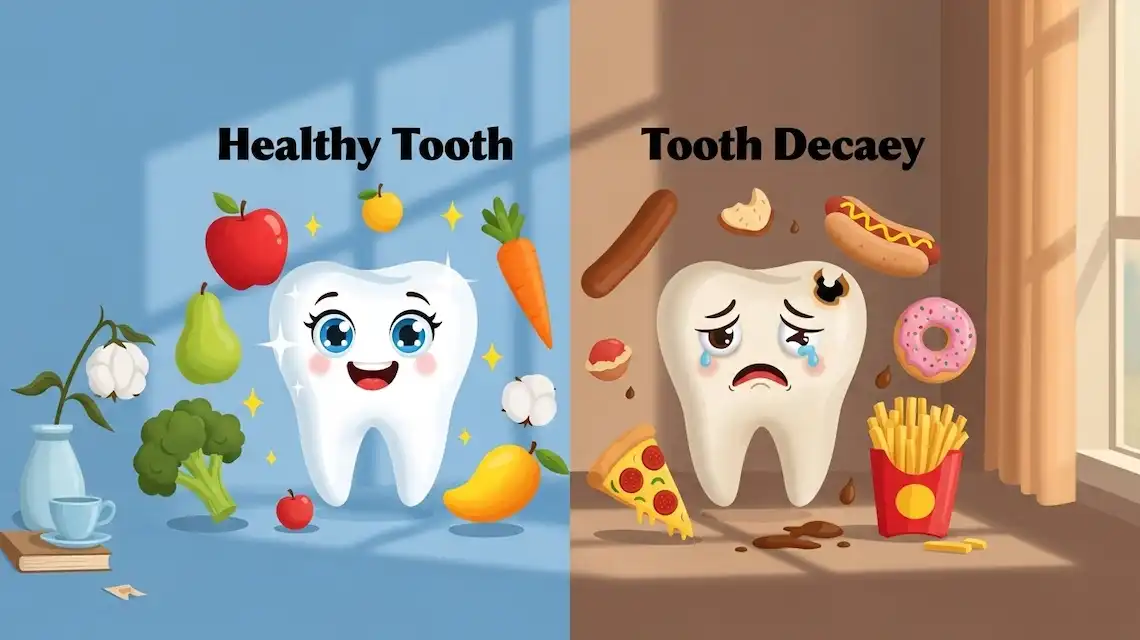
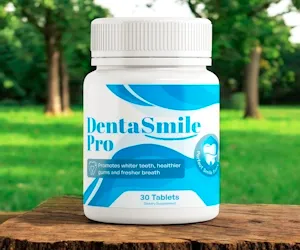
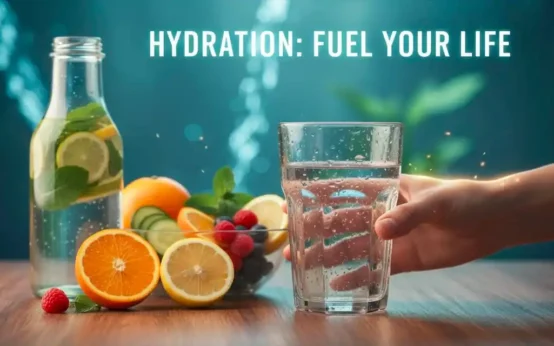 Importance of Hydration for Your Brain, Body, and Everyday Energy
Importance of Hydration for Your Brain, Body, and Everyday Energy  Why Is My Root Canal Tooth Sensitive
Why Is My Root Canal Tooth Sensitive  Infection of Wisdom Tooth Symptoms
Infection of Wisdom Tooth Symptoms 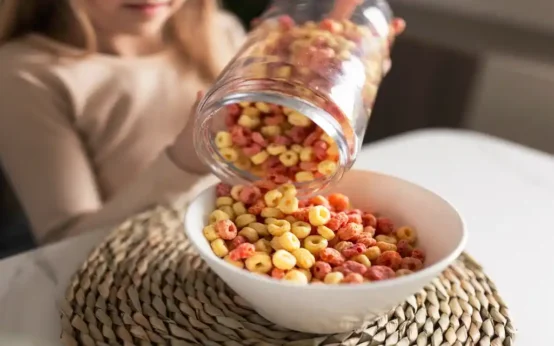 Healthiest Breakfast Cereal for Children
Healthiest Breakfast Cereal for Children  Anxiety Management Techniques
Anxiety Management Techniques 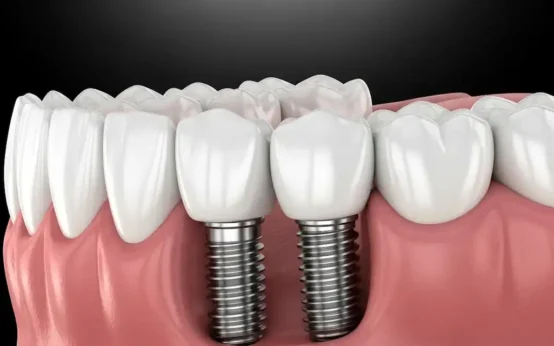 Advantages of Dental Implants
Advantages of Dental Implants